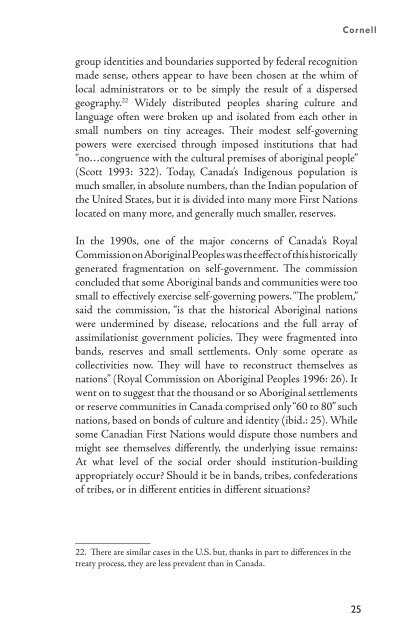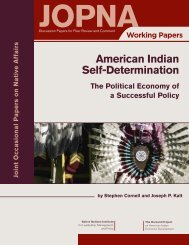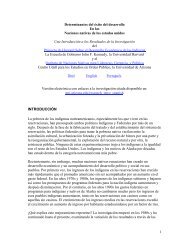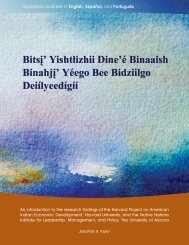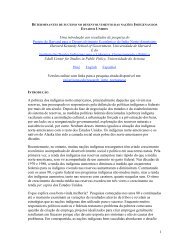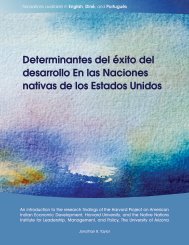<strong>Indigenous</strong> <strong>Peoples</strong>, <strong>Poverty</strong> <strong>and</strong> <strong>Self</strong>-<strong>Determ<strong>in</strong>ation</strong>traced the historical processes that encouraged Maori to alter thispolitical structure. Such structures are generally dynamic, but theEuropean agenda shaped the process of change <strong>in</strong> particular ways.Negotiat<strong>in</strong>g over l<strong>and</strong>, Europeans searched for <strong>and</strong> encouragedparamount chiefs at ever larger scales of social organization.Maori responded to l<strong>and</strong> pressure <strong>in</strong> part by comb<strong>in</strong><strong>in</strong>g <strong>in</strong> largerunits to defend their <strong>in</strong>terests. Over time, both Europeans <strong>and</strong>Maori tended to construct Maori—for purposes of <strong>in</strong>tergrouprelations—<strong>in</strong> fewer <strong>and</strong> larger social groups. The result was toprivilege iwi, (conceived as peoples, tribes or confederations ofhapu), over hapu. Formal government policy <strong>and</strong> the organizationof social programs have tended to cont<strong>in</strong>ue the trend <strong>in</strong> recentyears, lead<strong>in</strong>g to what Manuhuia Barcham (2000: 141) calls “theiwi-isation of Maori society.”But the situation is further complicated by cont<strong>in</strong>u<strong>in</strong>gdiversification. A majority of Maori now live <strong>in</strong> cities. Alongwith the more general <strong>in</strong>tegration of many Maori <strong>in</strong>to NewZeal<strong>and</strong> society, this has produced new sets of <strong>in</strong>terests that donot easily comb<strong>in</strong>e <strong>in</strong>to hapu or iwi constructions. Speak<strong>in</strong>g ofthe Maori concept of t<strong>in</strong>o rangatiratanga, a polysemous conceptthat comb<strong>in</strong>es ideas of, among other th<strong>in</strong>gs, sovereignty, selfdeterm<strong>in</strong>ation,autonomy, nationhood, <strong>and</strong> chiefta<strong>in</strong>ship, Maaka<strong>and</strong> Fleras remark that “for some, t<strong>in</strong>o rangatiratanga resideswith<strong>in</strong> the hapu; for others, the iwi; for still others only Maori asa collectivity; <strong>and</strong> for yet others still, with<strong>in</strong> the <strong>in</strong>dividual” (2000:100). Under these conditions, what form should self-governmenttake?In Canada, as <strong>in</strong> the United States, a lengthy history of treatymak<strong>in</strong>g,l<strong>and</strong> loss, <strong>and</strong> paternalistic federal adm<strong>in</strong>istration hasreshaped Aborig<strong>in</strong>al political relationships <strong>and</strong> group boundaries.Particularly under the Indian Act of 1876 <strong>and</strong> its subsequentamendments, the government of Canada recognized variousgroups of Aborig<strong>in</strong>al people as b<strong>and</strong>s, recognized certa<strong>in</strong> l<strong>and</strong>s asreserved to those b<strong>and</strong>s, replaced <strong>Indigenous</strong> governmental forms<strong>and</strong> practices with imposed ones, <strong>and</strong>, on behalf of assimilationistgoals, regulated numerous aspects of Aborig<strong>in</strong>al life. While some24
Cornellgroup identities <strong>and</strong> boundaries supported by federal recognitionmade sense, others appear to have been chosen at the whim oflocal adm<strong>in</strong>istrators or to be simply the result of a dispersedgeography. 22 Widely distributed peoples shar<strong>in</strong>g culture <strong>and</strong>language often were broken up <strong>and</strong> isolated from each other <strong>in</strong>small numbers on t<strong>in</strong>y acreages. Their modest self-govern<strong>in</strong>gpowers were exercised through imposed <strong>in</strong>stitutions that had“no…congruence with the cultural premises of aborig<strong>in</strong>al people”(Scott 1993: 322). Today, Canada’s <strong>Indigenous</strong> population ismuch smaller, <strong>in</strong> absolute numbers, than the Indian population ofthe United States, but it is divided <strong>in</strong>to many more First Nationslocated on many more, <strong>and</strong> generally much smaller, reserves.In the 1990s, one of the major concerns of Canada’s RoyalCommission on Aborig<strong>in</strong>al <strong>Peoples</strong> was the effect of this historicallygenerated fragmentation on self-government. The commissionconcluded that some Aborig<strong>in</strong>al b<strong>and</strong>s <strong>and</strong> communities were toosmall to effectively exercise self-govern<strong>in</strong>g powers. “The problem,”said the commission, “is that the historical Aborig<strong>in</strong>al nationswere underm<strong>in</strong>ed by disease, relocations <strong>and</strong> the full array ofassimilationist government policies. They were fragmented <strong>in</strong>tob<strong>and</strong>s, reserves <strong>and</strong> small settlements. Only some operate ascollectivities now. They will have to reconstruct themselves asnations” (Royal Commission on Aborig<strong>in</strong>al <strong>Peoples</strong> 1996: 26). Itwent on to suggest that the thous<strong>and</strong> or so Aborig<strong>in</strong>al settlementsor reserve communities <strong>in</strong> Canada comprised only “60 to 80” suchnations, based on bonds of culture <strong>and</strong> identity (ibid.: 25). Whilesome Canadian First Nations would dispute those numbers <strong>and</strong>might see themselves differently, the underly<strong>in</strong>g issue rema<strong>in</strong>s:At what level of the social order should <strong>in</strong>stitution-build<strong>in</strong>gappropriately occur? Should it be <strong>in</strong> b<strong>and</strong>s, tribes, confederationsof tribes, or <strong>in</strong> different entities <strong>in</strong> different situations?22. There are similar cases <strong>in</strong> the U.S. but, thanks <strong>in</strong> part to differences <strong>in</strong> thetreaty process, they are less prevalent than <strong>in</strong> Canada.25
- Page 1 and 2: Joint Occasional Papers on on Nativ
- Page 3 and 4: CornellIndigenous Peoples, Poverty
- Page 5 and 6: CornellIndigenous Peoples, Poverty
- Page 7 and 8: CornellIndigenous Peoples, Poverty
- Page 9 and 10: CornellObviously the differences ar
- Page 11 and 12: CornellCommonalitiesAlthough there
- Page 13 and 14: CornellThe present inquiry, while p
- Page 15 and 16: CornellCentral governments, on the
- Page 17 and 18: Cornellstark discrepancy between In
- Page 19 and 20: Cornellusual economic factors such
- Page 21 and 22: CornellThe meaning and role of self
- Page 23 and 24: Cornellis needed. Those nations mak
- Page 25 and 26: CornellThe U.S. government had inad
- Page 27 and 28: CornellSuch variation does not nega
- Page 29: CornellBern and Dodds discuss the s
- Page 33 and 34: CornellThe overall policy implicati
- Page 35 and 36: CornellReferencesAnaya, S.J. 1996.
- Page 37 and 38: Cornell-----. 1995. ‘Where does e
- Page 39 and 40: CornellHarvard Project on American
- Page 41 and 42: CornellJorgensen, M., and J. Taylor
- Page 43 and 44: CornellNative Nations Institute for
- Page 45 and 46: CornellWakeling, S., M. Jorgensen,
- Page 47 and 48: Joint Occasional Papers on Native A


